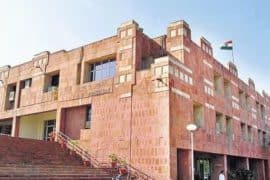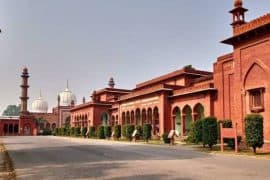As you read this in your flagged shelters, a heart in Ayodhya prays for a land they lost in ‘Ram ke Naam.’
In November 2022, TV screens flood with thankful statements for the residents of Ayodhya’s cooperation with the city’s ‘vikaas’. The eight-lane development is now being launched. But it came with a sacrifice, a sacrifice of their own ‘bhoomi’ to welcome ‘Ram’ in the ‘Janmabhoomi’. This piece highlights how the reconstructed Ram Mandir affected hundreds of homes and employment while shedding light on the government’s commitment and action towards the displaced.
The establishment of the Ram Mandir on the historically disputed site brought in a significant surge in investments from both the central and state governments. The proposed redevelopment towards Janmabhoomi is reportedly said to be completed over ten years with an estimated budget of almost 85,000 crores. As per the Economic Times report, the tourist footfall in the district had already increased from 0.6 crore (2021–22) to 2.3 crore (2022–2023), generating revenue for local businesses and ‘creating’ employment opportunities.
While the city shines with its claims of employment, the roads have a completely different story to tell. According to BBC reports, the expansion of three key roads—Rampath (spanning thirteen kilometres), Bhaktipath (eight hundred metres), and Janmabhoomi Path (eight hundred metres)—resulted in the demolition of numerous homes and shops, impacting nearly 1,400 families. In November 2022, TV screens were flooded, acknowledging the demolition but also the promises of rehabilitation and compensation—koi unka shoshan nahi kar paayega (nobody would be able to exploit the displaced). While the government commits to shielding over the exploitation, the streets of Ayodhya cry for help, almost losing the hopes they were once given. Some claim that the demolitions were undertaken without a clear compensation policy, while others claim not even receiving one.
The Wire mentions Neelam Maurya, a resident of Ayodhya, as she reflects on her partially demolished home.
“In January of this year, the partial demolition of my house meant that I lost my beauty parlour, and my husband lost the general store he used to run. My husband is now operating the store in a small space in front of the house. I received Rs 1,60,000 as compensation for the building, but it would cost me around Rs 10 lakh to make it liveable after the demolition.” Her beauty parlour is now closed.
The BBC reports Kamala Devi, who runs her small business in a rented shop on Rampath, as she says, “Hum kahaan ko jaaye? Ek laakh rupaye mei kya hota hai? Humein paisa nahi, dukaan chahiye”. Where shall we go? What happens with a compensation of Rs. 1 lakh? We want a shop, not money.) expressing her anguish over the compensation received by the government. Bhagvat Prasad Pahadi, another shop owner at Rampath, mentions receiving a compensation of three lakhs for his three shops, estimated to be thirty-five lakhs.
A report released by the Hindustan Times in 2022 also mentioned how the shop owners are in favour of the demolition drive while tenants are opposing it. Nand Lal Gupta, the trader leader, claimed that shop owners are not permitting their tenants to reconstruct demolished shops. Gupta also accused the local administration of being almost ignorant about this. The Ayodhya District Magistrate (ADM) highlighted the complexity of establishing settlements for shopkeepers, citing ongoing disputes with some of the shop owners. Nevertheless, the government claims its commitment to assisting the affected shopkeepers through its various schemes, as well as providing help through loans. Harilal Gupta,a shopkeeper working in a rented shop, mentions (BBC) that the agreement letter was signed by him and now stands on who would actually get the compensation of one lakh. The ADM then said that some shopkeepers, including Harilal, had the shops on government-owned land and had therefore been demolished. It claims that almost 212 shopkeepers have been relocated to new shops and that they have been given compensation based on the base price and not on the market value. In a statement to the BBC, Nitish Kumar, District Magistrate at Ayodhya, highlights how the government is providing the necessary documents and fair compensation for the demolition of shops. Contrary to this, Ramji, another shop owner, alleges that he never received an agreement letter, and his shop was demolished without his consent. In contrast, Misri Lal asserts that he personally dismantled his shop as soon as he received compensation from the government.
Street expansion not only demolished shops but also fueled land displacement through Ayodhya’s various projects. As reported by The Quint, 41-year-old Maniram Yadav’s house in Ayodhya’s Ramkot was demolished in 2021 by the authorities to construct a police station. Yadav, like many others, approached the authorities and was informed about living on encroached land. Residents question the payment of house tax and electricity bills if they’ve been living on an encroachment. They argue that much of the Ayodhya city is built on government land (nazul land or patta), also claiming that the authorities took away the land they had actually bought from the government. It’s been 1.5 years since the demolition, and Yadav and many others still knock on the doors of authorities, hoping for that one ray of light and a fulfilled promise.
Ayodhya still undergoes a series of demolitions for its widening and developmental projects, but some chose to surrender in the name of their faith, while others lost hope in the government’s assistance.
Read Also: The Green Curtains of G20: Solution to All of Bharat’s Woes
Featured Image Source- BBC
Dhairya Chhabra





Comments are closed.